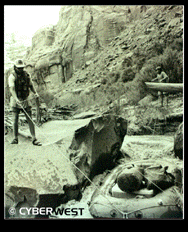May 17, 1996
Skiers think snow is something to slide around on, but river rats know better. Snow becomes waves on Western rivers.
Kayakers and rafters keep a close watch on snowpack figures to predict conditions and plan trips. Many of the West’s most pristine and remote river trips are available on smaller rivers floatable only during high water. For the larger rivers, high water isn’t the difference between floating and scraping, it’s the difference between little waves and big waves. High water translates into a high level of excitement.

Expectations are running high for river rats this year. Unusually heavy snows in the northern reaches of the Colorado Rockies promise good action on rivers north of I-70 this summer. Winter storms pummeled the northern Colorado Rockies leaving most basins at roughly 150% of normal.
Such snow levels indicate some rip-snorting high water, but weather patterns will continue to dictate river characteristics. Should May prove warm and sunny in the northern Rockies, expect a fast surge of water down area rivers. If too much snow melts all at once, watch out for flooding, particularly in the tributaries of the upper Colorado River in Colorado. But, should Mother Nature bestow a gradual warming trend or a cool and wet late spring and early summer, look for an extended high-water period stretching into late June or even early July. Last year’s cool, wet spring and early summer left boaters floating in some cold and wet weather, but offered in consolation high water on the upper Colorado basin into mid-July.
Commercial outfitters in the northern Rockies of Colorado stand to have plenty of thrills to offer a bountiful crop of paying customers, but private boaters will reap the sort of benefits money can’t buy. High water means fast water and private boaters will find they can cover more river miles in less time — and that translates into more river miles and more waves per trip.
Snowpack also opens up smaller rivers runnable only in high water. An increasingly popular pastime for river types is running smaller water in very small boats. Rivers such as Colorado’s Fraser River through Fraser Canyon or the Escalante River (pictured above) in Utah are passable only when the river is running high. Major excursions through remote but stunning canyons such as the Jarbidge in Idaho happen only at peak flows (or close to it). A strong snowpack doesn’t guarantee anything, but it greatly increases the chances for running such rivers.
Northern reaches of the Rockies are still snowbound (significant melting hasn’t begun yet above 9,000 feet), while the southern Colorado Rockies are suffering. The upper Colorado basin (Grand Lake to Dotsero cutoff) is glorying in a 149% snowpack year, while the Dolores and San Miguel basin is languishing at 60%. The upper Rio Grande basin matches that dry figure at 61%. Low snowpacks force reservoir operators to hoard water which strangles some rivers. Releases from McPhee Reservoir on the upper Dolores River, for example, are not expected to rise higher than 200 cubic feet per second at any time this season. Flows of 800 cfs are needed to float the river, meaning the Dolores is essentially off limits this summer.
High water doesn’t always create more intense rivers. Those who ran the lower San Juan last summer found the already mellow river completely devoid of whitewater. The river was running fast but the high water volume literally swallowed the handful of Class II and Class III rapids usually found on the San Juan. The drops were there, but underwater. On top it was a marshmallow float and a great place for a swim on a sweltering day. The San Juan, however, should be considered the exception and not the rule. Every river changes character as river flows change, but generally bigger water means bigger, more difficult stretches of whitewater.
The antithesis to the San Juan might be the various forks of the Salmon River in Idaho. Fiercely and justifiably popular rivers for week-long outings, the Salmon River and its tributaries are not often run until late June. With no reservoirs, the Salmon is one of the few rivers still experiencing spring runoff in all its natural glory. The already big waves of the Salmon, with mid-summer flows of 10,000-20,000 cfs, reach epic proportions in late May and early June when flows will double, triple or even quadruple late-summer totals (depending on snowpack, melting conditions and rain). Consequently, river permits are required (and are difficult to obtain) from June 20 throughout the summer. Earlier than that, no advance permit is required, just courage.
Below are snowpack figures as reported by the U.S. Bureau of Reclamation, April 30.
|
Bear River, 144% |
 |
While snowpacks influence river flows, daily fluctuations are caused by rains and reservoir releases. Before boating any river, consult managing agencies first for up-to-date flow information.
Photos and story by Doug Freed